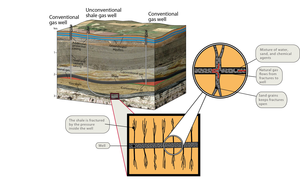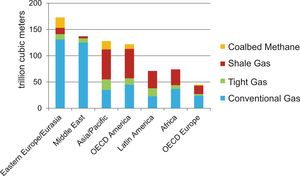What is shale gas?
Shale Gas is natural gas that is present in shale rocks. Throughout the world, different types of sedimentary rock contain natural gas deposits, for example sandstones, limestones or shales. Sandstone rocks often have high permeability, which means that the tiny pores within the rock are well connected and gas can flow easily through the rock. In contrast, shale rocks usually have very low permeability, making gas production more complex and costly.
Shale gas is considered a so-called “unconventional gas”, together with “tight gas” from sandstones or limestones with low permeability and “coal bed methane” (CBM). While both conventional and unconventional deposits do host natural gas, it’s the more elaborate production methods that distinguish unconventional from conventional deposits; hydraulic fracturing (Fig. 1) is often applied to unconventional natural gas deposits. The distribution of different types of natural gas deposits varies around the world´s different regions, see Fig. 2.
Formation
Like oil and coal, natural gas in shales has, essentially, formed from the remains of plants, animals, and micro-organisms that lived millions of years ago. Though there are different theories on the origins of fossil fuels, the most widely accepted is that they are formed when organic matter (such as the remains of a plant or animal) is buried, compressed and heated in the earth´s crust for long time. In the case of natural gas, this is referred to as thermogenic methane generation.
Though the basic principles of shale gas formation are fairly well understood, generation of the gas within individual shales may differ significantly. Better knowledge is needed e.g. on basin modeling, petrophysical characterization, or gas flow in shales for an improved understanding of unconventional reservoirs.
For European gas shales this research is conducted within GASH, the first European interdisciplinary shale gas research initiative. GASH integrates available knowledge on European shales and conducts research projects in order to predict shale gas formation and occurrence in time and space.







